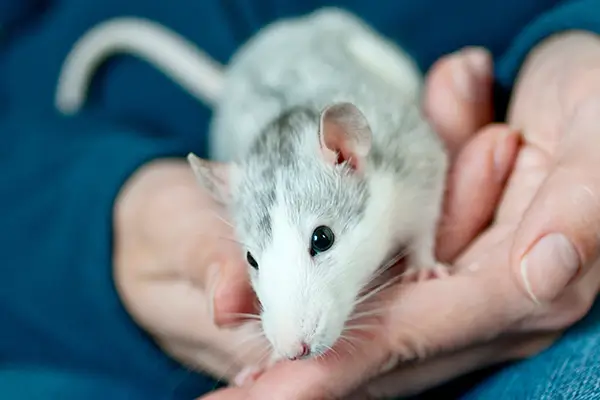
Animal Allergy – The Nightmare for Animal Lovers
An animal allergy is the nightmare of all pet owners, as a severe allergy may necessitate separation from the beloved pet. Some people even discover for the first time that they have an animal allergy when they get a pet or take care of friends' or neighbors' animals. Often, the term “animal hair allergy” is used, but in reality, allergy symptoms are almost always triggered by specific proteins found in the saliva or excretions of dogs, cats, and other animals. Since animal allergies can cause dangerous conditions such as allergic asthma, they must be taken seriously. However, this type of allergy can be well diagnosed and treated.
This article introduces some animals that can trigger allergies, describes allergy symptoms, and discusses possible treatments. Click on the section that interests you most in the table of contents to continue reading.

Which animals can trigger an animal allergy?
Animal allergies are especially known among mammals, with which many people frequently come into contact. Pets and farm animals such as cats, dogs, horses, rabbits, or budgerigars are among the animals that can trigger allergies. Since all these animals have thick fur or feathers, it was once believed that the hair or feathers were responsible for the symptoms. Therefore, the term “animal hair allergy” or “feather allergy” is still often used today. However, hair and feathers act more as carriers for the actual allergens that adhere to them.
-
 Cats are very popular pets, which unfortunately can trigger allergies in many people. The cat allergy is probably the most diagnosed and treated animal allergy, as the animals are widespread and can cause severe symptoms in allergy sufferers, including allergic asthma. Cats produce a protein complex called Fel d 1 – these proteins are found in the cat's saliva and other secretions and cause the cat allergy. When grooming and marking, the allergens are transferred to the fur and skin. Loose hair and skin flakes then come into contact with human mucous membranes or respiratory tracts, provoking an immune reaction. Therefore, it is possible to be allergic to hairless cats as well. The amount of allergens produced varies between cat breeds, so some cats frequently trigger cat allergies, while others do so only rarely.
Cats are very popular pets, which unfortunately can trigger allergies in many people. The cat allergy is probably the most diagnosed and treated animal allergy, as the animals are widespread and can cause severe symptoms in allergy sufferers, including allergic asthma. Cats produce a protein complex called Fel d 1 – these proteins are found in the cat's saliva and other secretions and cause the cat allergy. When grooming and marking, the allergens are transferred to the fur and skin. Loose hair and skin flakes then come into contact with human mucous membranes or respiratory tracts, provoking an immune reaction. Therefore, it is possible to be allergic to hairless cats as well. The amount of allergens produced varies between cat breeds, so some cats frequently trigger cat allergies, while others do so only rarely. -
 Dogs also carry potentially allergy-causing enzymes in their saliva. In dogs, too, the allergen is transferred to the dog's hair through grooming, and some breeds have a lot of hair that they shed in large quantities. However, a dog with very dense or long hair is not automatically an “allergy dog.” Just as with cats, the amount of allergens in saliva varies between dog breeds. For example, poodles or Yorkshire terriers are considered dogs that only cause mild allergic reactions.
Dogs also carry potentially allergy-causing enzymes in their saliva. In dogs, too, the allergen is transferred to the dog's hair through grooming, and some breeds have a lot of hair that they shed in large quantities. However, a dog with very dense or long hair is not automatically an “allergy dog.” Just as with cats, the amount of allergens in saliva varies between dog breeds. For example, poodles or Yorkshire terriers are considered dogs that only cause mild allergic reactions. -
 Horses possess an allergen called Equ c 1. This protein belongs to the lipocalins, which have functions in the cellular metabolism of nearly all living organisms. Since they are found in the skin and hair of the horse, this is referred to as a "horse hair allergy." The proteins are also found in horse excrement. Interestingly, there are often cross allergies with the proteins found in the saliva of cats and dogs. Horse allergy sufferers are therefore often also allergic to dogs or cats. However, horse hair allergy is one of the less frequently diagnosed animal hair allergies, as despite the high density of riders in Germany, only a relatively small part of the population regularly interacts with horses.
Horses possess an allergen called Equ c 1. This protein belongs to the lipocalins, which have functions in the cellular metabolism of nearly all living organisms. Since they are found in the skin and hair of the horse, this is referred to as a "horse hair allergy." The proteins are also found in horse excrement. Interestingly, there are often cross allergies with the proteins found in the saliva of cats and dogs. Horse allergy sufferers are therefore often also allergic to dogs or cats. However, horse hair allergy is one of the less frequently diagnosed animal hair allergies, as despite the high density of riders in Germany, only a relatively small part of the population regularly interacts with horses. -
 Rabbits and guinea pigs are very popular small pets. Especially children love to cuddle with the fluffy creatures. However, care should be taken to see if children develop allergies to the animals. In rabbits and guinea pigs, the allergens are in the urine. Keeping the animals in a clean and hygienic environment and regularly cleaning their cages helps ensure that as few allergens as possible get into the fur and from there onto humans.
Rabbits and guinea pigs are very popular small pets. Especially children love to cuddle with the fluffy creatures. However, care should be taken to see if children develop allergies to the animals. In rabbits and guinea pigs, the allergens are in the urine. Keeping the animals in a clean and hygienic environment and regularly cleaning their cages helps ensure that as few allergens as possible get into the fur and from there onto humans. -
 Mice and rats are bred as pets but also come into contact with humans as pests in rural and urban environments. The allergens of these rodents are primarily found in their dander and urine. There is even a known "Laboratory Animal Allergy" (LAA) triggered by lab mice, which frequently affects employees in animal labs. The symptoms of a "mouse allergy" resemble classic hay fever, but in the long run can also escalate to allergic asthma.
Mice and rats are bred as pets but also come into contact with humans as pests in rural and urban environments. The allergens of these rodents are primarily found in their dander and urine. There is even a known "Laboratory Animal Allergy" (LAA) triggered by lab mice, which frequently affects employees in animal labs. The symptoms of a "mouse allergy" resemble classic hay fever, but in the long run can also escalate to allergic asthma. -
 Birds like budgies or parrots can also cause allergies. Allergens are found in the excretions or saliva glands, from where they enter the feathers. Mite droppings in the feathers could play another role – however, bird mites are not the same as house dust mites. Moreover, ornamental birds kept under hygienic conditions usually do not have mites. Although a "feather allergy" is often mentioned, the feathers themselves are not to blame for the symptoms. However, some bird species have so-called powder down feathers, which break down into fine dust and serve to clean the plumage. This feather dust can cause allergy-like irritations. Additionally, allergies might also be triggered by mold or mite droppings in bird food as well as by substances in bird bedding. If a bird allergy is suspected, it is essential to clarify the accompanying circumstances in detail to rule out other allergens.
Birds like budgies or parrots can also cause allergies. Allergens are found in the excretions or saliva glands, from where they enter the feathers. Mite droppings in the feathers could play another role – however, bird mites are not the same as house dust mites. Moreover, ornamental birds kept under hygienic conditions usually do not have mites. Although a "feather allergy" is often mentioned, the feathers themselves are not to blame for the symptoms. However, some bird species have so-called powder down feathers, which break down into fine dust and serve to clean the plumage. This feather dust can cause allergy-like irritations. Additionally, allergies might also be triggered by mold or mite droppings in bird food as well as by substances in bird bedding. If a bird allergy is suspected, it is essential to clarify the accompanying circumstances in detail to rule out other allergens.

Symptoms and Effects of Pet Allergies
A pet allergy can take years to manifest. It is not uncommon for people who, for example, had no problems with cats for a long time, to develop a cat allergy. Once a pet allergy is present, it manifests as an immediate-type allergy – symptoms appear immediately to within a few minutes after contact with the allergen. The symptoms of various pet allergies are very similar – those who keep dogs, cats, and other animals together only know after an allergy test which animal is "responsible." Identifying pet hair allergies can also be complicated by the similarity of symptoms to typical hay fever complaints.
- Cold-like symptoms such as a runny or stuffy nose and frequent sneezing can indicate a pet allergy. Of course, it could also be allergic rhinitis or a normal cold. On their own, these symptoms are usually not enough to consider that one might be allergic to dogs, cats, or other animals.
- Burning, itchy, and watery eyes are a common accompaniment to pet allergies. The discomfort often worsens significantly if the eyes are rubbed – they can then swell, become bright red, and tear profusely. In the case of a cat allergy, such eye problems are common. If the issues arise shortly after contact with an animal, they are a clear indication of a possible pet allergy.
- Rashes and hives occur less frequently in pet allergies and are not considered typical symptoms.
If a pet allergy is not recognized and treated or simply ignored, it is difficult to predict how it will develop. Like other allergies, it may weaken over time and almost disappear – a sort of natural hyposensitization occurs. However, the allergy may also become stronger – especially in allergic children, continued contact with pet allergens is warned against as it may lead to the development of allergic asthma. Therefore, you should seek medical help if you believe that you or your children are suffering from a pet allergy.

Diagnosing, Treating, and Preventing Animal Allergies
To diagnose an animal allergy, your doctor will first conduct an anamnesis interview. The symptoms of an animal hair allergy can also be caused by other allergies or illnesses. If the suspicion is confirmed that animal allergens are indeed behind your symptoms, an allergy test can provide clarity. The usual procedure is a prick test: allergen-containing liquid is dropped onto the skin, which is then slightly scratched through the drop. The allergen can thus penetrate the upper layer of skin. If you are allergic to the tested substance, a noticeable but harmless skin reaction will occur. In some cases, blood tests are also conducted to confirm allergies.
Depending on the severity of the animal allergy, it may be necessary to avoid contact with the affected animals. This measure can be particularly painful for pet owners, but separation does not have to be permanent. For mild symptoms, medications to relieve symptoms can be taken. Often, an allergy weakens over time on its own—continued contact with the animals could lead to a natural desensitization. However, since an allergy can also become more severe—especially in children—it's important to consult with a doctor about the necessary steps.
Hyposensitization can be performed in an allergy clinic, and it can reduce allergy symptoms over a multi-year process. Patients are given small doses of the allergen, which are gradually increased over months to slowly accustom the immune system to the irritant. Good results have been achieved, for example, with cat allergies. However, not every animal hair allergy can be treated in this way.
It is uncertain whether animal allergies can be prevented. It is certain, however, that avoiding pets does not protect against an allergy. Even people who have never had a pet or had little contact with animals can develop an animal allergy. It may even be that having a pet tends to protect against an allergy because the immune system becomes accustomed to the allergens. The origin of an allergy to animal proteins is not yet scientifically understood. Therefore, animal allergy is a highly individual condition that must be assessed anew for each patient.



